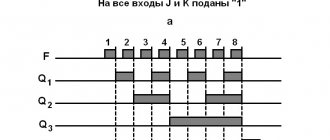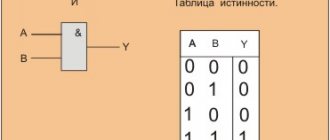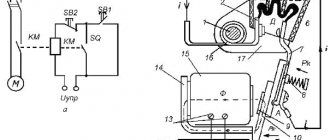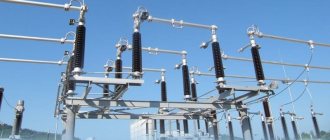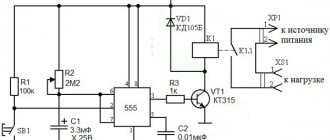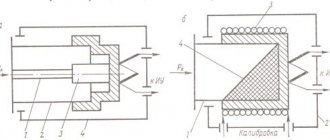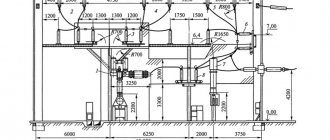What are logical triggers?
A trigger is the simplest sequential device that can be in one of two possible states and transition from one state to another under the influence of input signals. A trigger is the basic element of sequential logic devices. Trigger inputs are divided into information and control (auxiliary). This division is largely arbitrary. Information inputs are used to control the trigger state. Control inputs are typically used to preset a flip-flop to some state and for synchronization.
Vasiliev Dmitry Petrovich
Professor of Electrical Engineering, St. Petersburg State Polytechnic University
Ask a Question
Triggers can have 2 outputs: direct Q and inverse Q.
Triggers are classified according to various criteria, so there is a fairly large number of classifications. Unfortunately, these classifications do not form a coherent system, but an engineer needs to know them.
Trigger classification
- by the method of receiving information;
- according to the principle of construction;
- by functionality.
Asynchronous trigger
Asynchronous trigger - changes its state immediately at the moment the corresponding information signal appears.
Vasiliev Dmitry Petrovich
Professor of Electrical Engineering, St. Petersburg State Polytechnic University
Synchronous triggers - react to information signals only if there is a corresponding signal at the so-called synchronization input C (from the English clock). This input is also designated by the terms “strobe”, “tact”.
Synchronous triggers
Synchronous flip-flops, in turn, are divided into flip-flops with static (static) and dynamic (dynamic) control via the synchronization input C. Static flip-flops perceive information signals when a logical one (direct input) or a logical zero (inverse input) is applied to input C.
Dynamic triggers perceive information signals when the signal at input C changes (changes) from 0 to 1 (direct dynamic C-input) or from 1 to 0 (inverse dynamic C-input).
Static triggers
Static triggers, in turn, are divided into single-stage (single-cycle) and two-stage (push-pull). A single-stage trigger has one stage of storing information, and a two-stage trigger has two such stages. First, information is recorded in the first stage, and then rewritten into the second and appears at the output. A two-stage trigger is designated by TT.
Synchronous and asynchronous triggers
These groups are created on the principle of dependence of output states on clock pulses.
Asynchronous triggers
Products of this type change the state of stored information after receiving the corresponding input data. The slight delay is explained by the time it takes for the signal to travel through the chain of switching elements of the circuit.
Synchronous triggers with dynamic clocking
This group contains products controlled by synchronizing pulses. State switching is performed on a rising or falling edge. When there is no activity in C, the data is stored in an unchanged state, regardless of the arrival of new information.
Designation of trigger inputs
Flip-flop inputs are usually designated as follows:
S —input for setting to state “1”;
R —input for setting to state “0”;
J - input for setting to state “1” in a universal trigger;
K - input for setting to state “0” in a universal trigger;
T — counting (general) input;
D — input for setting to state “1” or state “0”;
V - additional control input to allow receiving information (sometimes the letter E is used instead of V).
Let's look at some types of triggers and their implementation on logical elements.
Classification
Capacitor energy
Products in this category are divided into two main groups based on the principle of control signals. In the first, a specified sequence of output signals is generated if the state is set to “1”. After moving to “0”, generation stops. The second is capable of switching the output voltage accordingly. Typically, "1" roughly corresponds to the power supply level.
Triggers are also distinguished according to the following parameters:
- synchronization of work cycles;
- static (dynamic) control methods;
- complexity of logic circuits;
- one- or two-stage.
Triggers on logic elements and on an operational amplifier
An amplifier circuit with two stages is well suited for implementing static triggers. The connection between them is organized directly or with limiting resistors in the corresponding circuits.
Trigger on logical elements
Schmitt Trigger
Products in this category can be created using different element bases. This section discusses the Schmitt trigger on transistors. It is controlled by changing an analog signal. Depending on the voltage level, the memory state is switched to the corresponding position “0” or “1”.
Schmidt trigger on transistors with a connected load
Asynchronous RS flip-flop
Let us turn to an asynchronous RS trigger, which has a conventional graphic symbol shown in Fig. 3.54.
The trigger has two information inputs: S (from the English set) and R (from the English reset).
It is convenient to describe the law of operation of triggers using a transition table, which is sometimes also called a truth table (Fig. 3.55). S', R', Q' denote the corresponding logical signals occurring at some time t, and Qt + 1 the output signal at the next time t+1.
The combination of input signals S' = l, R' =1 is often called forbidden, since after it the trigger finds itself in a state (1 or 0), which is impossible to predict in advance. Such situations should be avoided.
The trigger in question can be implemented on two NOR elements (Fig. 3.56).
It is necessary to ensure that this circuit functions in full accordance with the transition table above.
The K564TP2 microcircuit contains 4 asynchronous RS triggers and one control input (Fig. 3.57).
Abrahamyan Evgeniy Pavlovich
Associate Professor, Department of Electrical Engineering, St. Petersburg State Polytechnic University
When a low level is applied to the input V, the outputs of the triggers are disconnected from the pins of the microcircuits and go into the third so-called high-impedance state. When a logical signal “1” is applied to input V, the flip-flops operate in accordance with the above transition table.
In an asynchronous RS flip-flop using NAND elements, switching is performed by a logical “0” applied to the R or S input, i.e., the inverse of the previously discussed transition table is implemented (Fig. 3.58). A prohibited combination corresponds to logical “0” at both inputs.
Brief theoretical information
Triggers are designed to store binary information. The use of triggers makes it possible to implement RAM devices (that is, memory in which information is stored only for the duration of calculations).
However, flip-flops can also be used to build some digital memory devices, such as counters, serial-to-parallel converters, or digital delay lines.
RS trigger
The main trigger on which all other triggers are based is the RS trigger. The RS trigger has two logical inputs:
- R – setting 0 (from the word reset);
- S – setting 1 (from the word set).
The RS trigger has two outputs:
- Q – straight;
- Q - reverse (inverse).
The state of the trigger is determined by the state of the direct output. The simplest RS flip-flop consists of two logic elements covered by cross positive feedback.
Let's look at how the trigger works:
Let R=0, S=1. The lower logical element performs the logical OR-NOT function, i.e. 1 at any of its inputs leads to the fact that its output will have a logical zero Q=0. The output Q will be 1 (Q=1), because zeros are supplied to both inputs of the upper element (one zero from input R, the other from output). The trigger is in a single state. If we now remove the setting signal (R=0, S=0), the situation at the output will not change, because Although the lower input of the lower logic gate will receive a 0, its upper input will receive a 1 from the output of the upper logic gate.
It will be interesting➡ What is inductance
The flip-flop will remain in the single state until a reset signal is received at the R input. Let now R=1, S=0. Then Q=0, a =1. The trigger switched to “0”. If after this you remove the reset signal (R=0, S=0), then the trigger will still not change its state. To describe the operation of a trigger, a table of states (transitions) is used. Let's denote:
- Q(t) – state of the trigger before the arrival of control signals (changes at inputs R and S);
- Q(t+1) – trigger state after changes at inputs R and S.
Transition table of RS flip-flop in NOR basis
| R | S | Q(t) | Q(t+1) | Explanations |
| Information storage mode R=S=0 | ||||
| 1 | 1 | |||
| 1 | 1 | Unit setting mode S=1 | ||
| 1 | 1 | 1 | ||
| 1 | Zero setting mode R=1 | |||
| 1 | 1 | |||
| 1 | 1 | * | R=S=1 prohibited combination | |
| 1 | 1 | 1 | * |
An RS trigger can also be built using “AND-NOT” elements (Figure 2.2).
Inputs R and S are inverse (active level “0”). The transition (switching) of this trigger from one state to another occurs when one of the inputs is set to “0”. The combination R=S=0 is prohibited.
Transition table of RS flip-flop in the “2AND-NOT” basis
| R | S | Q(t) | Q(t+1) | Explanations |
| * | R=S=0 prohibited combination | |||
| 1 | * | |||
| 1 | Zero setting mode R=0 | |||
| 1 | 1 | |||
| 1 | 1 | Unit setting mode S=0 | ||
| 1 | 1 | 1 | ||
| 1 | 1 | Information storage mode R=S=1 | ||
| 1 | 1 | 1 | 1 |
Synchronous RS trigger
The RS flip-flop circuit allows you to remember the state of the logic circuit, but since a transient process may occur when the input signals change (in digital circuits this process is called “dangerous races”), you need to remember the states of the logic circuit only at certain moments in time, when all transient processes are completed, and the signal at the output of the combinational circuit corresponds to the function it performs. This means that most digital circuits require a synchronization signal (clock signal).
All transient processes in a combinational logic circuit must end during the period of the clock signal supplied to the inputs of the flip-flops. Flip-flops that remember input signals only at the time specified by the synchronization signal are called synchronous. A schematic diagram of a synchronous RS flip-flop is shown.
Transition table of synchronous RS flip-flop
| R | S | C | Q(t) | Q(t+1) | Explanations |
| 1 | Information storage mode R = S = 0 | ||||
| 1 | 1 | 1 | |||
| 1 | 1 | 1 | Unit setting mode S =1 | ||
| 1 | 1 | 1 | 1 | ||
| 1 | 1 | Zero setting mode R=1 | |||
| 1 | 1 | 1 | |||
| 1 | 1 | 1 | * | R = S = 1 prohibited combination | |
| 1 | 1 | 1 | 1 | * |
In table 2.3. By signal C we mean a sync pulse. Without a clock pulse, a synchronous RS flip-flop retains its state.
Synchronous RS trigger
Consider a synchronous RS flip-flop (Fig. 3.59).
If the input C is logical “0”, then both the output of the upper input element “AND-NOT” and the output of the lower one will be logical “1”. And this, as noted above, ensures the storage of information.
Vasiliev Dmitry Petrovich
Professor of Electrical Engineering, St. Petersburg State Polytechnic University
Ask a Question
Thus, if the input C is logical “0”, then the influence on the inputs R, S does not lead to a change in the state of the trigger.
If a logical unit is applied to the synchronization input C, then the circuit reacts to input signals in exactly the same way as the one discussed earlier (Fig. 3.56).
Story
A functional trigger can be created from a conventional relay with an electromechanical drive. By properly setting the control circuit contacts, the power group is turned on after a certain combination of input signals. A separate key performs a reset.
RS trigger circuit on one relay
Electronic analogues were assembled at the beginning of the last century from lamp devices. The current schemes were first published by Russian and English scientists in 1918-20. Later, semiconductor transistors began to be used. Nowadays, corresponding devices are created using microelectronic technologies.
MS type trigger
Let's consider the principle of constructing a two-stage trigger, which is also called an MS type trigger (from the English master, slave, which is usually translated as “master” and “slave”). Its simplified block diagram is shown in Fig. 3.60. The circuit has two single-stage triggers (master M and slave S) and two electronic keys (Cl1 and Cl2).
The timing diagram of the synchronization signal, explaining the operation of the trigger, is shown in Fig. 3.61.
Let's consider a number of time intervals of the indicated diagram:
t < ta — the leading trigger is disconnected from the information inputs, the slave trigger is connected to the master;
ta < t < tb — the leading trigger is disconnected from the information inputs, the slave trigger is disconnected from the master;
tb < t < tc — the master trigger is connected to the information inputs, the slave trigger is disconnected from the master. The master flip-flop records the information supplied to the inputs;
tc < t < td — the leading trigger is disconnected from the information inputs, the slave trigger is disconnected from the master;
td < t - the master trigger is disconnected from the information inputs, the slave trigger is connected to the master, information from the master trigger is rewritten to the slave. This occurs immediately after time td and means that, in fact, a two-stage flip-flop is triggered when the clock signal changes from 1 to 0. In this case, the output signals are determined by those input information signals that occurred immediately before the negative edge of the clock signal.
How to use the freebie trigger more ethically?
Give your potential client the opportunity to get to know each other better. Give a checklist, a book, give away a webinar that you can’t get anywhere for free.
For example, during a report at the “Let’s Write” conference, I promised to give listeners a webinar about the author’s style in texts. And she posted a link to it in the Telegram channel along with a greeting and a short introduction.
And this is the approach I consider beneficial for both sides:
- The listeners themselves decided whether they wanted to continue communicating with me after the conference - they could pick up the gift without subscribing to the channel itself.
- And I got a new audience - people who are interested in what I write about and what I broadcast.
Group membership trigger
Abraham Maslow, in his hierarchical model of needs, said that immediately after the closure of basic needs and the acquisition of security, a person wants to be part of a community - his pack. He wants attention, love and support from those close to him in spirit. Therefore, the trigger of belonging to a group works great in selling educational projects by subscription - clubs, mastermind groups and closed communities.
So Varvara Lyalagina invites you to her closed community for creative entrepreneurs “Studio”. She says who is already in the “Studio”, and emphasizes that, despite all the commonality, everyone has their own rhythm and speed of mastering materials.
Trigger of individuality and special conditions
We often respond to this trigger when we see phrases like “only for girls/boys/housewives/freelancers”, or “you will only get this information from me and nowhere else”, or “this price is only valid for those who have subscribed”.
For example, I recently came across a special conditions trigger in the description of a Telegram channel for men:
Here's how a marketing coach uses a special conditions trigger:
There are only 4 lines, but they contain:
- an indication of where you need to be to receive special conditions;
- the condition itself, expressed in a clear figure - you can save 1,500 rubles;
- exclusivity - you can’t find this anywhere else;
- A call to action is the next step you need to make clear to the reader.
Social proof trigger
Triggered when we see other people praising a product, service, person or brand. We go to choose a robot vacuum cleaner and see why people give it stars. We read the landing page of the online course and again look for confirmation of our expectations in the reviews.
How can you use the social proof trigger for personal promotion?
- Show customer reviews with screenshots.
- Tag the client in a post about collaboration.
- Repost a client review post on your page.
- You can also ask your audience to share what they value about your activity or content. For example, like this:
People themselves come to the comments and write wonderful things of their own free will, and this captivates those who are not yet familiar with the author:
Trigger of paradox and contradiction
This is a technique with which we show the reader that he does not need to perform the target action. Although we mean that it is necessary to do this.
For example, I announce my latest article on storytelling in the channel. And I warn you: be careful, you can get stuck in it. On the one hand, the word “stick” has a negative connotation associated with wasting time. On the other hand, I controversially compensate for this meaning with the promise of benefits and a clear plan for immersion in the topic.
Intrigue Trigger
It is used when you need to emphasize the benefits of a product, but you can’t just “touch” it.
For example, I wanted to share what a wonderful text I analyzed together with the project participants in a closed channel. The content in the channel is paid, I can’t give it away just like that, so there was a post-intrigue. And three sales from it.
Result trigger + free trigger
These are not all the triggers that I know, but the main ones. To complete the typology, I would like to answer the question “Is it possible to use several triggers at once in one text?”
Yes, you can, but it is important to maintain a balance. If on a sales landing page several screens long, the use of 7–10 triggers is acceptable and even necessary, then the post on social networks will be too concentrated. The reader can immediately consider 5–7–10 triggers as aggression, but 2–3 are quite compatible.
As an example, I’ll give a fragment of a post where the result trigger is supported by a free trigger.
This move motivates the audience not just to take information, but also to extract value for themselves. Reach the end and don’t quit what you started halfway. This is important because in online education, the so-called “unavailability” of students is a big pain.
JK trigger
Let's consider a JK flip-flop (from the English jump and keep), which differs from the considered RS flip-flop in that the appearance of logical units at both information inputs (J and K) (for direct inputs) leads to a change in the state of the trigger. This combination of signals for a JK flip-flop is not prohibited.
Otherwise, the JK flip-flop is similar to the RS flip-flop, with the role of the S input being played by the J input, and the role of the R input being played by the K input.
JK flip-flops are implemented as MS flip-flops or as dynamic flip-flops (i.e., JK flip-flops are synchronous).
In Fig. Figure 3.62 shows a conventional graphic designation of a two-stage JK trigger.
Let's turn to dynamic triggers. They are characterized by blocking information inputs at the moment when the received information is transmitted to the output. It should be noted that in terms of response to input signals, a dynamic trigger, triggered when the signal at input C changes from 1 to 0, is similar to the considered two-stage trigger, although they differ in internal structure.
For direct dynamic C-input, use the designations shown in Fig. 3.63, a, and for the inverse dynamic C-input, use the notation shown in Fig. 3.63, b.
Physical implementations of triggers
The base element is created from semiconductor devices using modern technological processes to miniaturize functional products.
Logic element based on MOS transistors
Triggers with thyristors
To increase the power of the connected load, you can assemble a trigger using thyristors. Input S is connected to the control electrode, and input R is connected to the gate. To maintain a constant voltage at the anode, a transistor connected to the appropriate circuit is suitable.
Triggers on relay-contactor base
Despite the general trends of miniaturization, it is quite possible to create a functional trigger from a relay. Such solutions, in particular, are used to protect power circuits when turning on powerful electric drives.
D-trigger
Let's consider a D-flip-flop (from the English delay), which repeats the input state at its output. Speaking purely theoretically, a D-flip-flop can be formed from any RS or JK flip-flops if mutually inverse signals are simultaneously applied to their inputs (Fig. 3.64).
Abrahamyan Evgeniy Pavlovich
Associate Professor, Department of Electrical Engineering, St. Petersburg State Polytechnic University
Information storage in D-flip-flops is ensured by synchronization, therefore all real D-flip-flops have two inputs: information D and synchronization C. In this flip-flop, the input signal is recorded by the synchronization signal and transmitted to the output. Since the output information remains unchanged until the next synchronization pulse arrives, the D flip-flop is also called a flip-flop with information storage or a latch flip-flop.
The graphical symbol for a D-flip-flop is shown in Fig. 3.65.
What is a trigger
Trigger is a trigger translated from English as “trigger”. Any little thing can become an impetus for us to take certain actions. We smell the aroma of coffee and fresh cinnamon rolls and feel the urge to snack. We see the sunset on the sea and take pictures. We hear a child crying - we experience anxiety and irritation. We run a feather over the skin and get goosebumps.
We can say that a trigger is an event that causes a strong reaction in a person: anger, interest, irritation, joy, tears or pain. Sometimes these reactions are at the level of emotions and impulses, sometimes at the level of the body and physical sensations.
What else to read about triggers
Joseph Sugarman, in his book How to Write Great Advertising Copy, talks about copywriting techniques and the principles of hooks that can catch the reader.
Mara Einstein in her book “Undercover Advertising” writes that behind many texts on the Internet there is a commercial interest, and not just a desire to share emotions. He gives a lot of examples of hidden advertising that we see everywhere.
Robert Cialdini, in his book “The Psychology of Influence,” analyzes the mechanisms of motivation, assimilation of information and decision-making. The book will be useful to those who need to work with people and convince them.
Jonah Berger talks about how to create content that people will share in her book Contagious. He gives specific techniques for creating viral messages or advertisements.
Marshall Goldsmith, in his book Triggers, writes about the opposite: how to recognize hooks, overcome unwanted reactions to stimuli, and use external conditions to achieve your own goals.
How to use triggers and is it possible to do without them?
But aren’t triggers manipulation and is it possible to do without them altogether? This question is often asked to me by participants in the course on texts for social networks, when we go through hype topics and learn to use triggers in the text.
I believe that with the advent of the Internet and social networks, all content has become triggering. Remember how the social media feed is blown up by harmless posts about first-graders with bouquets (they drag their children into the ribbons, they’re sick of it already!), gender holidays (don’t congratulate me, I don’t celebrate!), the results of the year (they hesitated with their results!), and you will understand , what am I talking about.
So I am in favor of using triggers, but do it consciously and ethically:
- Be consistent. You can’t write in one post about how you don’t have time to fend off clients, and in the next post you can’t write about looking for new ones.
- Don't go overboard with the drama. Finding a client’s “pain” and offering a solution is normal. Picking at a wound to see flesh and bones is horrible and repulsive.
- Do not use all triggers in one text at once. It is better to make a series of several touches.
And important: look at who your audience is and select triggers that will be interesting to them.
